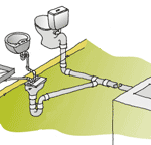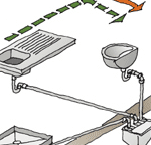Water
Water use, sustainability, and efficiency by choosing quality systems and materials, and providing environmentally friendly solutions.
Designing an on-site wastewater treatment system
The appropriate wastewater treatment system will depend on the site, the required capacity, and compliance requirements.
On this page:
- site considerations
- system options
- system capacity
- building consents
Also see design checklist.
Site considerations
Site features that must be considered when designing a wastewater disposal system, include:
- Is the water table high or low?
- Does the land become saturated during periods of high rainfall?
- What area of land is available for the system?
- What is the soil’s ability to absorb moisture, e.g. is the subsoil clay, sand, loam etc?
- Can the proposed site be accessed by the heavy vehicles needed for installation and cleaning?
- Will the tanks be a minimum 5 m from any building?
Note: The amount of land needed for the disposal field depends on the subsoil.
System designs

- Schematic of on-site domestic wastewater treatment
Where a sewerage connection is not available, the on-site wastewater treatment system must meet the performance requirements of the NZBC.
Local authorities or regional councils may have their own bylaws controlling an installation and resource consent may be required. Contact the local authority before you begin to design a system.

- Schematic of separate on-site domestic greywater and blackwater treatment systems
Greywater and blackwater may be treated separately. If separate treatment systems are selected, you should include a means of diverting the greywater to the blackwater treatment system.

- Schematic of an on-site domestic greywater treatment system used in combination with a waterless composting toilet
A composting toilet eliminates the need for a blackwater system but must incorporate a means of dealing with urine. The greywater can be dispersed to a land application or used for irrigation.
System capacity
Allow for a daily output of 200 litres per person when designing a system. This will enable it to cope with peak discharge rates or temporary overloads. It must also be able to retain the total flow for at least of 24 hours.
The system should also have enough capacity for 3–5 years of sludge at the following rates:
- for blackwater and greywater – 80 litres per person per year
- for blackwater only (where there is separate greywater system) – 50 litres per person per year
- for greywater only – 40 litres per person per year.
The sewage system capacity must allow for:
- variations in the quantity of effluent to be disposed of
- the possibility that householders will not manage and maintain the system effectively.
Building consents
An on-site treatment system requires building consent. The consent application should include:
- Detailed site plans to scale showing site boundaries, topography, buildings, easements and the disposal field.
- A detailed system design report with equipment specifications and sizes and disposal field layout.
- Construction drawings of components.
- Site and soil evaluation reports.
- A producer statement (PS1) from an appropriately-qualified design engineer that the design complies with Building Code clauses B1, B2 and G13.
- Performance tests or certified approvals.
After the system has been installed, the building consent authority will require:
- as-built drainage plans
- a construction producer statement (PS3) by the contractor confirming that the installation complies with Building Code clause G13
- a construction review producer statement (PS4) by the engineer confirming that the installation complies with clause G13
- proof that a maintenance contract has been arranged with a suitably qualified contractor.
If local planning rules do not include discharge from an on-site sewage treatment system as a permitted activity, a resource consent will also be required.
Updated: 17 April 2019

